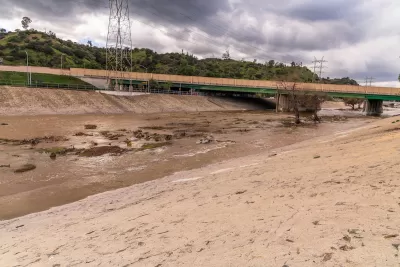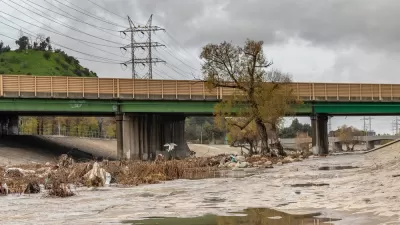During this “super year” of storms, L.A. County has successfully captured 96 billion gallons of stormwater which is enough to meet the needs of about 2.4 million people a year.

Los Angeles County has managed to capture and store a significant amount of stormwater brought forth by heavy rains this winter and spring which sent torrential flows down local creeks and rivers. Specifically, an estimated 295,000 acre-feet of water since last October or 96.3 billion gallons was captured. This is sufficient to meet the water needs of approximately 2.4 million people a year, which is almost one-fourth of the county’s population of ten million residents.
As reported by Ian James, the county, working in coordination and collaboration with the Los Angeles Department of Water and Power and other agencies, was able to capture and store this amount of water thanks in part to investments totaling over $1 billion since 2001. Some of the funding has been used to raise dams and increase the capacity of spreading grounds, where water is sent into basins and then percolates underground into aquifers.
The county has also spent more than $1 billion since 2001 to remove sediment from reservoirs to ensure their water-catching capacity is not limited or diminished. A large portion of the funds have come from the L.A. County Flood Control District, which receives revenues through property taxes. Funding for stormwater-catching infrastructure is also generated through the Safe, Clean Water Program, which was established after county voters passed Measure W in 2018.
Though the amount of runoff captured since October has been substantial, the county’s facilities took in more water during the major storms over the previous 12 months — an estimated 626,000 acre-feet, which is enough to supply about five million residents for a year.
To learn more, please read the source article.
FULL STORY: L.A. County captures 96 billion gallons of water during ‘super year’ of storms

Study: Maui’s Plan to Convert Vacation Rentals to Long-Term Housing Could Cause Nearly $1 Billion Economic Loss
The plan would reduce visitor accommodation by 25,% resulting in 1,900 jobs lost.

North Texas Transit Leaders Tout Benefits of TOD for Growing Region
At a summit focused on transit-oriented development, policymakers discussed how North Texas’ expanded light rail system can serve as a tool for economic growth.

Using Old Oil and Gas Wells for Green Energy Storage
Penn State researchers have found that repurposing abandoned oil and gas wells for geothermal-assisted compressed-air energy storage can boost efficiency, reduce environmental risks, and support clean energy and job transitions.

Santa Barbara Could Build Housing on County Land
County supervisors moved forward a proposal to build workforce housing on two county-owned parcels.

San Mateo Formally Opposes Freeway Project
The city council will send a letter to Caltrans urging the agency to reconsider a plan to expand the 101 through the city of San Mateo.

A Bronx Community Fights to Have its Voice Heard
After organizing and giving input for decades, the community around the Kingsbridge Armory might actually see it redeveloped — and they want to continue to have a say in how it goes.
Urban Design for Planners 1: Software Tools
This six-course series explores essential urban design concepts using open source software and equips planners with the tools they need to participate fully in the urban design process.
Planning for Universal Design
Learn the tools for implementing Universal Design in planning regulations.
Ascent Environmental
Borough of Carlisle
Institute for Housing and Urban Development Studies (IHS)
City of Grandview
Harvard GSD Executive Education
Toledo-Lucas County Plan Commissions
Salt Lake City
NYU Wagner Graduate School of Public Service





























